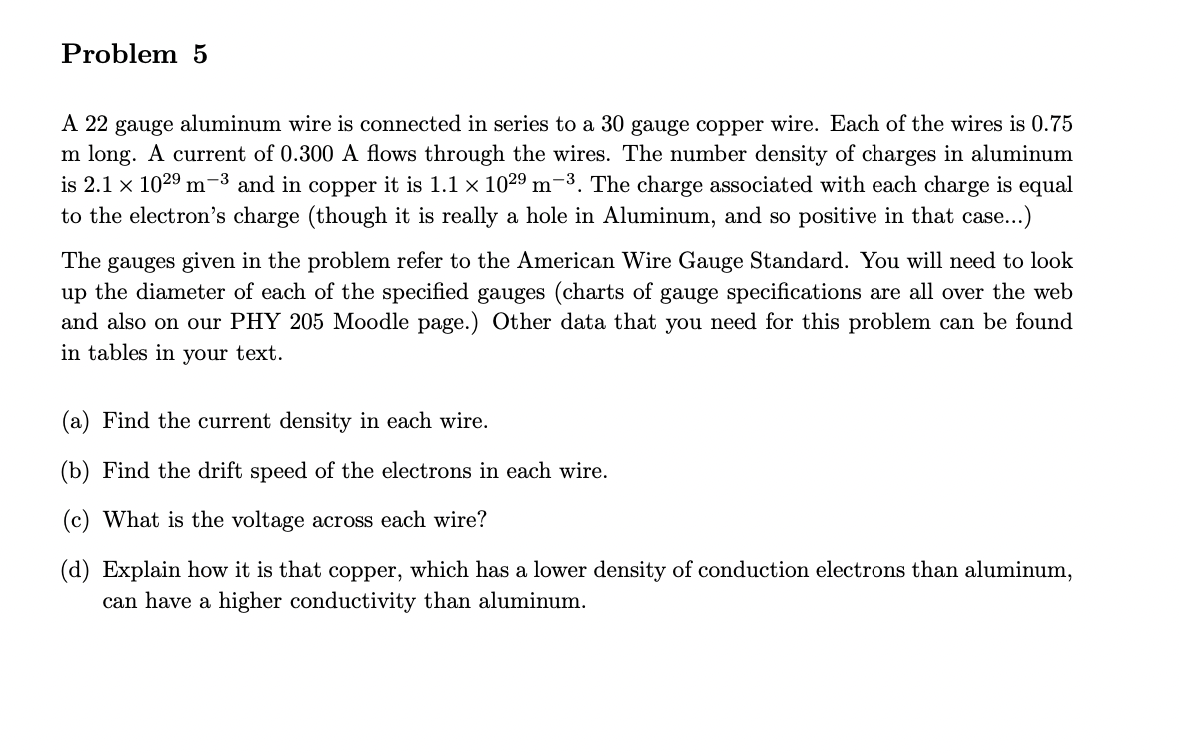A 22 gauge aluminum wire is connected in series to a 30 gauge copper wire. Each of the wires is 0.75 m long. A current of 0.300 A flows through the wires. The number density of charges in aluminum is 2.1 x 102⁹ m-3 and in copper it is 1.1 x 102⁹ m-³. The charge associated with each charge is equal to the electron's charge (though it is really a hole in Aluminum, and so positive in that case...) The gauges given in the problem refer to the American Wire Gauge Standard. You will need to look up the diameter of each of the specified gauges (charts of gauge specifications are all over the web and also on our PHY 205 Moodle page.) Other data that you need for this problem can be found in tables in your text. (a) Find the current density in each wire. (b) Find the drift speed of the electrons in each wire. (c) What is the voltage across each wire? (d) Explain how it is that copper, which has a lower density of conduction electrons than aluminum, can have a higher conductivity than aluminum.
A 22 gauge aluminum wire is connected in series to a 30 gauge copper wire. Each of the wires is 0.75 m long. A current of 0.300 A flows through the wires. The number density of charges in aluminum is 2.1 x 102⁹ m-3 and in copper it is 1.1 x 102⁹ m-³. The charge associated with each charge is equal to the electron's charge (though it is really a hole in Aluminum, and so positive in that case...) The gauges given in the problem refer to the American Wire Gauge Standard. You will need to look up the diameter of each of the specified gauges (charts of gauge specifications are all over the web and also on our PHY 205 Moodle page.) Other data that you need for this problem can be found in tables in your text. (a) Find the current density in each wire. (b) Find the drift speed of the electrons in each wire. (c) What is the voltage across each wire? (d) Explain how it is that copper, which has a lower density of conduction electrons than aluminum, can have a higher conductivity than aluminum.
Related questions
Question
a-d would be greatly appreciated

Transcribed Image Text:Problem 5
A 22 gauge aluminum wire is connected in series to a 30 gauge copper wire. Each of the wires is 0.75
m long. A current of 0.300 A flows through the wires. The number density of charges in aluminum
is 2.1 × 102⁹ m-³ and in copper it is 1.1 × 10²⁹ m−³. The charge associated with each charge is equal
to the electron's charge (though it is really a hole in Aluminum, and so positive in that case...)
The gauges given in the problem refer to the American Wire Gauge Standard. You will need to look
up the diameter of each of the specified gauges (charts of gauge specifications are all over the web
and also on our PHY 205 Moodle page.) Other data that you need for this problem can be found
in tables in your text.
(a) Find the current density in each wire.
(b) Find the drift speed of the electrons in each wire.
(c) What is the voltage across each wire?
(d) Explain how it is that copper, which has a lower density of conduction electrons than aluminum,
can have a higher conductivity than aluminum.
Expert Solution
This question has been solved!
Explore an expertly crafted, step-by-step solution for a thorough understanding of key concepts.
Step by step
Solved in 5 steps
